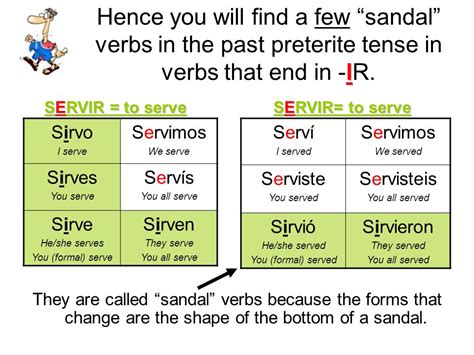Spanish is a beautiful language, and mastering its various verb conjugations can be a rewarding experience for language learners. Among the many verb forms, the preterite form of servir (to serve) is particularly useful for expressing completed actions in the past. In this article, we will delve into the world of servir and explore its preterite form in detail.
Servir is an essential verb in Spanish, as it can be used in various contexts, such as serving food, serving a purpose, or serving a sentence. Understanding the preterite form of servir will allow you to communicate more effectively in Spanish and enhance your overall language skills.
Understanding the Preterite Form of Servir

The preterite form of servir is used to describe completed actions in the past. It is an essential verb form to master, as it is used in a wide range of contexts, from formal to informal writing and speaking. The preterite form of servir is conjugated as follows:
- Yo serví (I served)
- Tú serviste (you served)
- Él/ella/usted sirvió (he/she/you formal served)
- Nosotros/as servimos (we served)
- Vosotros/as servisteis (you all served)
- Ellos/as sirvieron (they served)
Using the Preterite Form of Servir in Context
To illustrate the use of the preterite form of servir, let's consider a few examples:
- Yo serví la comida en el restaurante anoche. (I served food at the restaurant last night.)
- Ella sirvió como presidenta de la empresa durante cinco años. (She served as president of the company for five years.)
- Nosotros servimos en el ejército durante la guerra. (We served in the army during the war.)
Key Differences Between the Preterite and Imperfect Forms of Servir

When using the verb servir, it's essential to distinguish between the preterite and imperfect forms. The imperfect form is used to describe ongoing or repeated actions in the past, whereas the preterite form is used for completed actions.
- Imperfect form: servía (I was serving), servías (you were serving), servía (he/she/you formal was serving), servíamos (we were serving), servíais (you all were serving), servían (they were serving)
- Preterite form: serví (I served), serviste (you served), sirvió (he/she/you formal served), servimos (we served), servisteis (you all served), sirvieron (they served)
Practical Exercises to Practice the Preterite Form of Servir
To practice the preterite form of servir, try the following exercises:
- Write a short paragraph describing a time when you served food or drink to someone.
- Conjugate the verb servir in the preterite form for the following subjects: yo, tú, él/ella/usted, nosotros/as, vosotros/as, ellos/as.
- Create a short dialogue between two people discussing their past experiences serving in a restaurant or other context.
Common Mistakes to Avoid When Using the Preterite Form of Servir

When using the preterite form of servir, be mindful of the following common mistakes:
- Using the imperfect form instead of the preterite form for completed actions.
- Conjugating the verb servir incorrectly in the preterite form.
- Forgetting to use the correct verb ending for the subject pronoun.
Tips for Mastering the Preterite Form of Servir
To master the preterite form of servir, follow these tips:
- Practice conjugating the verb servir in the preterite form regularly.
- Read and listen to Spanish texts and conversations to become familiar with the verb form in context.
- Focus on understanding the nuances between the preterite and imperfect forms of servir.
Using the Preterite Form of Servir in Different Contexts

The preterite form of servir can be used in various contexts, including:
- Formal writing: The preterite form of servir is commonly used in formal writing, such as academic papers, business reports, and official documents.
- Informal conversations: The preterite form of servir can also be used in informal conversations with friends, family, or colleagues.
- Historical events: The preterite form of servir can be used to describe historical events or actions that occurred in the past.
Real-Life Examples of the Preterite Form of Servir
To illustrate the use of the preterite form of servir in different contexts, consider the following examples:
- El presidente sirvió durante dos mandatos. (The president served for two terms.)
- Ella servía en el ejército durante la guerra, pero ahora trabaja como médica. (She served in the army during the war, but now works as a doctor.)
- Nosotros servimos en el comedor de beneficencia durante el fin de semana. (We served at the soup kitchen over the weekend.)
Conclusion: Mastering the Preterite Form of Servir

Mastering the preterite form of servir is a crucial step in becoming proficient in Spanish. By understanding the conjugation, usage, and nuances of the preterite form, you can improve your language skills and communicate more effectively.
Remember to practice regularly, focus on context, and be mindful of common mistakes. With dedication and effort, you can master the preterite form of servir and enhance your Spanish language abilities.
What is the preterite form of servir in Spanish?
+The preterite form of servir is used to describe completed actions in the past and is conjugated as follows: yo serví, tú serviste, él/ella/usted sirvió, nosotros/as servimos, vosotros/as servisteis, ellos/as sirvieron.
How is the preterite form of servir different from the imperfect form?
+The preterite form of servir is used for completed actions in the past, whereas the imperfect form is used for ongoing or repeated actions in the past.
What are some common mistakes to avoid when using the preterite form of servir?
+Common mistakes to avoid include using the imperfect form instead of the preterite form for completed actions, conjugating the verb servir incorrectly, and forgetting to use the correct verb ending for the subject pronoun.
